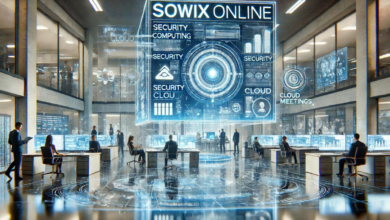Website Design: Crafting Digital Experiences

Website design is a critical aspect of building an effective online presence. In today’s digital age, a well-designed website can make the difference between a business’s success and failure. This blog post delves into the essential elements of website design, the importance of user experience (UX), current trends, and best practices. We will explore how to create visually appealing, functional, and user-friendly websites that meet the needs of your audience. Elevate your online presence on Google with Cape Cod Web designand experience a surge in potential leads and customers
The Importance of Website Design
Website design plays a pivotal role in how your audience perceives your brand. A poorly designed website can deter visitors and harm your brand’s reputation. On the other hand, a well-designed website can enhance user experience, increase engagement, and drive conversions. Website design is not just about aesthetics; it encompasses the entire user journey, from the moment they land on your site to the point of conversion.
First impressions matter. Studies have shown that users form an opinion about a website within 0.05 seconds. This split-second decision is influenced by various design elements, including layout, color scheme, typography, and imagery. A professional website design can convey trust, credibility, and professionalism, encouraging users to stay longer and explore further.
Key Elements of Website Design
Layout and Structure
The layout and structure of a website are fundamental to its usability. A well-organized layout helps users navigate the site effortlessly. Grid-based designs, for instance, provide a structured and visually pleasing arrangement of content. Consistency in layout across different pages ensures a cohesive user experience.
Color Scheme
Colors evoke emotions and play a crucial role in website design. Choosing the right color scheme can influence user behavior and brand perception. It’s essential to use colors that align with your brand identity and create a harmonious visual experience. Contrasting colors for text and background enhance readability, while a balanced color palette can make your site more attractive and engaging.
Typography
Typography is a vital aspect of website design that affects readability and overall aesthetics. Selecting the right fonts and font sizes can enhance user experience. Sans-serif fonts are often preferred for digital content due to their readability on screens. It’s important to maintain consistency in typography across the site to create a professional and cohesive look.
Imagery and Graphics
High-quality images and graphics can significantly enhance the visual appeal of your website. They should be relevant to your content and brand. The use of custom graphics, illustrations, and icons can add a unique touch to your website design and help communicate your message more effectively.
Navigation
Effective navigation is crucial for user experience. Intuitive menus, clear calls to action (CTAs), and a logical site structure help users find the information they need quickly. A well-designed navigation system can reduce bounce rates and increase user engagement. Website design should prioritize easy access to key sections and seamless transitions between pages.
The Role of User Experience (UX) in Website Design
User experience (UX) is a core component of website design. It focuses on creating a user-centric design that meets the needs and expectations of your audience. Good UX design involves understanding user behavior, preferences, and pain points to create an intuitive and enjoyable experience.
User Research
User research is the foundation of effective UX design. It involves gathering insights about your target audience through surveys, interviews, and usability testing. Understanding your users’ needs and preferences helps inform design decisions and ensures your website design is aligned with user expectations.
Wireframing and Prototyping
Wireframing and prototyping are essential steps in the UX design process. Wireframes provide a blueprint of the website layout, highlighting the placement of key elements without focusing on visual details. Prototyping, on the other hand, involves creating interactive mockups to test the functionality and flow of the site. These steps help identify potential issues and refine the website design before the final development stage.
Responsive Design
With the increasing use of mobile devices, responsive design has become a necessity. A responsive website design adapts to different screen sizes and resolutions, providing a consistent user experience across desktops, tablets, and smartphones. This approach not only enhances usability but also improves search engine rankings, as Google prioritizes mobile-friendly websites.
Accessibility
Accessibility is a crucial aspect of website design that ensures your site is usable by everyone, including people with disabilities. Implementing accessibility features, such as alt text for images, keyboard navigation, and screen reader compatibility, makes your site more inclusive and compliant with legal standards.
Current Trends in Website Design
Minimalism
Minimalism continues to be a popular trend in website design. It focuses on simplicity and clarity, with clean layouts, ample white space, and minimalistic elements. This approach reduces clutter and enhances the overall user experience, allowing users to focus on the content.
Dark Mode
Dark mode is gaining traction as a preferred option for many users. It reduces eye strain, especially in low-light environments, and can make certain elements stand out. Incorporating a dark mode option in your website design can cater to user preferences and improve overall satisfaction.
Microinteractions
Microinteractions are subtle animations or design elements that provide feedback to users and enhance interactivity. Examples include hover effects, button animations, and loading indicators. These small details can make the user experience more engaging and enjoyable.
Asymmetrical Layouts
Asymmetrical layouts break away from traditional grid-based designs, offering a more dynamic and visually interesting experience. This trend in website design allows for creative freedom and can make your site stand out from the competition.
3D Elements and Illustrations
The use of 3D elements and custom illustrations can add depth and uniqueness to your website design. These elements can create a more immersive experience and help communicate complex ideas in a visually appealing way.
Best Practices for Effective Website Design
Focus on Speed and Performance
Website speed and performance are critical factors in user experience and search engine rankings. Slow-loading websites can frustrate users and lead to higher bounce rates. Optimizing images, leveraging browser caching, and minimizing code can improve your site’s performance and enhance website design.
Prioritize Content
Content is the cornerstone of any website. High-quality, relevant content can attract and retain visitors, driving engagement and conversions. Your website design should highlight key content areas and ensure readability. Using clear headings, bullet points, and concise paragraphs can make your content more digestible.
Implement SEO Best Practices
Search engine optimization (SEO) is essential for improving your website’s visibility in search engine results. Incorporating SEO best practices into your website design can boost organic traffic and enhance user experience. This includes optimizing meta tags, using descriptive URLs, and ensuring mobile-friendliness.
Test and Iterate
Continuous testing and iteration are key to maintaining an effective website design. Regular usability testing, A/B testing, and user feedback can help identify areas for improvement and ensure your site meets user expectations. Staying updated with industry trends and evolving user preferences can keep your website relevant and competitive.
Security and Privacy
Ensuring the security and privacy of your users is paramount. Implementing SSL certificates, secure payment gateways, and robust data protection measures can build trust and confidence in your website design. Transparency about data usage and privacy policies is also crucial for user trust.
Conclusion
Website design is an ever-evolving field that requires a balance of creativity, functionality, and user-centric principles. A well-designed website can enhance user experience, build brand credibility, and drive business success. By focusing on key design elements, prioritizing user experience, staying abreast of current trends, and following best practices, you can create a compelling and effective online presence. Remember, website design is not a one-time task but an ongoing process of refinement and improvement to meet the changing needs and expectations of your audience.




